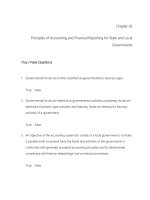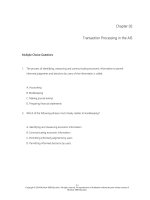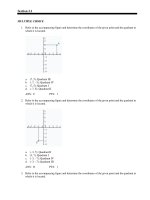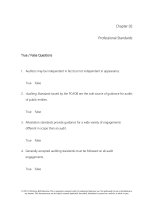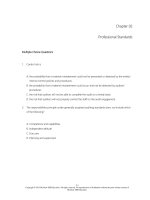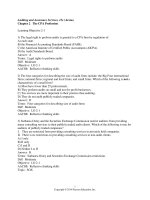Psychological consultation and collaboration in school and community settings 6th edition dougherty test bank
Bạn đang xem bản rút gọn của tài liệu. Xem và tải ngay bản đầy đủ của tài liệu tại đây (264.34 KB, 6 trang )
CHAPTER 2:
CONSULTANTS, CONSULTEES
AND COLLABORATORS
A.
BRIEF OVERVIEW
This chapter overviews the skills and roles needed to practice consultation and
collaboration in a culturally competent manner. It addresses the concepts of internal and external
as they relate to consultants. The chapter provides an overview of the various models of
consultation and examines the consultee as a variable in consultation. Finally, the chapter takes a
look at the current status of research in consultation and collaboration.
B.
KEY CONCEPTS AND TERMS
C.
Interpersonal skills
Communication skills
Group skills
Skills in working with cultural diversity
Skills in working with organizations
Ethical and professional behavior skills
Internal consultant
External consultant
Advocate
Expert
Trainer/educator
Collaborator
Fact finder
Process specialist
Process research
Outcome research
Quantitative research
Qualitative research
Models of consultation
Consultee as a variable
SUGGESTED TEACHING ACTIVITIES
1.
Divide the class into six groups. Have each group role-play one of the roles
discussed in the chapter. Then conduct an extensive discussion of the how the
roles vary from one another in terms of consultant behavior and consultee
behavior.
Psychological Consultation and Collaboration in School and Community Settings
29
D.
2.
Emphasize that consultants and collaborators can take on a variety of roles during
the same relationship. Use role-play to illustrate this point.
3.
Make sure students understand that, in the collaborative role, the consultant does
not take over the responsibility for the outcome of the intervention, nor does the
consultant take an active part in the intervention. Role-play a collaborative
approach to the conclusion of consultation to demonstrate this point. Again,
discuss the difference between the collaborative role in consultation and the
service of collaboration.
4.
Using the chalkboard or newsprint, discuss the advantages and disadvantages of
being an internal or an external consultant.
5.
In groups, have students discuss the ways in which the consultee is a variable how
consultation proceeds.
6.
Discuss the current status of research in consultation and collaboration. Help the
class develop implications for practice.
CASE SCENARIOS FOR ROLE-PLAYING ACTIVITIES
Situation #1 — Consultee is an administrator of a human services agency
A recent turnover in supervisory staff has caused morale problems. The new
supervisor has made changes in offices, case loads, and responsibilities. The staff is
displeased and morale is low. The administrator feels confident this new supervisor can
do the job, but he wants assistance in finding some solutions to help supervisor and staff
become more of a team. Role-play this scenario several times, each from a different role.
Situation #2 — Consultee is a college instructor
A student in an undergraduate class has appeared increasingly withdrawn and
despondent. The instructor has noticed changes in appearance, poor grades, and frequent
tardiness. The instructor is not sure how to approach the student to voice her concern or
what referral procedures to make once contact is made with the student. You are the
consultant. How would you proceed? Do you see any potential disadvantages to taking on
a nondirective role in this particular situation?
E.
30
QUESTIONS FOR DISCUSSION AND EXAMS
1.
Take each of the roles discussed in the text. Next, take each of the skill areas
mentioned in the text and show how each skill area can be used in each role. For
example, you might ask how communication, interpersonal, ethical and
professional behavior, cultural diversity, group, and organization skills are
important in the advocacy role. (Note: I find this to be a very good midterm
question).
2.
The internal consultant is always external to the problem. Explain.
Consultants, Consultees, and Collaborators
F.
3.
Cite several advantages to being an internal consultant. What advantages are there
to being an external consultant?
4.
The research in consultation and collaboration leaves much to be desired in terms
of quality. What things must happen for the research to be of higher quality?
5.
How would you describe the characteristics of an effective consultant?
6.
Explain how advocacy is a legitimate role for a consultant/collaborator to take on.
MULTIPLE-CHOICE QUESTIONS
1.
Which of the following roles do consultants take on when they believe a certain
course of action should be taken?
a.
Collaboration
b.
Counseling
c.
Advocate
d.
Mediation
ANS: C
REF: Common Consultation Roles (p. 37)
2.
All of the following attitudes are appropriate for consultants and collaborators
EXCEPT:
a.
unconditional regard.
b.
judgment of others’ personalities.
c.
empathy.
d.
genuineness.
ANS: B
REF: Characteristics of Effective Consultants and Collaborators (pp. 28-29)
3.
Psychological consultation and collaboration may occur in the following settings:
a.
an elementary school.
b.
a home-based business.
c.
a counseling center.
d.
a and c.
ANS: D
REF: Skills in Working with Organizations (p. 34)
4.
Interpersonal skills involved in consultation and collaboration should include:
a.
making the consultee feel comfortable.
b.
setting expectations about the consultative relationship.
c.
being comfortable with "oneself as a consultant."
Psychological Consultation and Collaboration in School and Community Settings
31
d.
all of the above.
ANS: D
REF: Interpersonal Skills (pp. 30-31)
5.
Communication skills involved in consultation and collaboration include all of the
following EXCEPT:
a.
nonverbal attending.
b.
Socratic questioning.
c.
expressing empathy.
d.
questioning.
ANS: B
REF: Communication Skills (pp. 31-32)
6.
A consultant who is in the role of teaching a new skill or concept is called:
a.
trainer/educator.
b.
expert.
c.
advocate.
d.
teacher.
ANS: A
REF: Common Consultation Roles (p. 39)
7.
The least directive role of a consultant is:
a.
advocate.
b.
process specialist.
c.
trainer/educator.
d.
all of the above.
ANS: B
REF: Common Consultation Roles (pp. 41-42)
8.
A consultant who is already part of the organization with which he/she is
consulting is an/a:
a.
internal consultant.
b.
advocate.
c.
external consultant.
d.
specialist.
ANS: A
REF: Internal and External Consultants (p. 42)
9.
32
Dixon and Dixon (1993) suggest that consultation research can be improved
through:
Consultants, Consultees, and Collaborators
a.
b.
c.
d.
expanding the measures used to evaluate it and by defining its
“boundary” conditions.
measuring changes in the consultant and the consultee.
measuring in the interactions between the consultant, consultee,
and client system.
all of the above.
ANS: D
REF: Research in Consultation and Collaboration (p. 46)
10.
Gresham and Kendall (1987) noted some of the more important things learned
about consultation from research include which of the following?
a.
Most outcome research is conducted on behavioral consultation.
b.
The empirical research support base is strongest for behavioral
consultation.
c.
Dependent variables tend to include the frequency of consultation
use by consultees and changes in clients, consultees, or both as a
result of consultation.
d.
All of the above.
ANS: D
REF: Research in Consultation and Collaboration (p 46)
11.
Which is most accurate?
a.
There is more research on consultation than these is on
collaboration.
b.
There is limited research on consultation in school settings.
c.
Research on mental health consultation outstrips that on other
models.
d.
Research on organizational consultation is almost non-existent.
ANS: A
REF: Research in Consultation and Collaboration (p. 47)
12.
Specific multicultural skills include:
a.
working with groups.
b.
good communication skills.
c.
neither a nor b.
d.
both a and b.
ANS: C
REF: Skills Related to Cultural Diversity (p. 32)
13.
Which are important examples of ethical behavior for consultants?
a.
Acting with integrity
b.
Adhering to an ethical code
Psychological Consultation and Collaboration in School and Community Settings
33
c.
d.
Maintaining personal and professional growth
All of the above
ANS: D
REF: Ethical and Professional Behavior Skills (pp. 35-36)
14.
The personal growth orientation of consultants involves:
a.
willingness of a consultant to grow and change as a person.
b.
understanding oneself as a racial and cultural being.
c.
involves consultants modeling change.
d.
all of the above.
ANS: D
REF: Characteristics of Effective Consultants and Collaborators (p. 28)
15.
The consultant/collaborator skill-set of working with groups is:
a.
not all that important.
b.
increasing in use.
c.
just like working with individuals.
d.
relies less on problem-solving.
ANS: B
REF: Group Skills (p. 34)
34
Consultants, Consultees, and Collaborators
